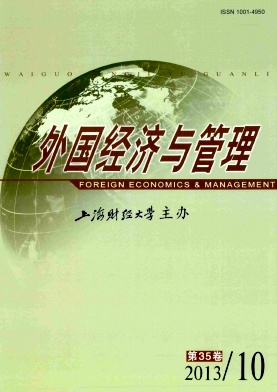创业新组拼理论溯源、主要内容探析与未来研究展望
外国经济与管理 2013 年 第 35 卷第 10 期, 页码:2 - 12
摘要
参考文献
摘要
本文从介绍法国结构人类学家列维-斯特劳斯提出的"bricolage"概念着手,首先探索了创业新组拼研究的理论渊源,然后在阐述创业新组拼与资源环境建构间关系的基础上,总结了创业新组拼理论的三个关键构念,并对建构主义视角下的新组拼创业过程进行了阐释,最后对创业新组拼理论的未来研究进行了展望。
[1]Amabile T M.The social psychology of creativity:A compo-nential conceptualization[J].Journal of Personality and SocialPsychology,1983,45(2):357-368.
[2]Baker T,et al.Improvising firms:Bricolage,account giving andimprovisational competencies in the founding process[J].Re-search Policy,2003,32(2):255-276.
[3]Baker T and Nelson R E.Creating something from nothing:Resource construction through entrepreneurial bricolage[J].Administrative Science Quarterly,2005,50(3):329-366.
[4]Baker T.Resources in play:Bricolage in the Toy Store(y)[J].Journal of Business Venturing,2007,22(5):694-711.
[5]Barney J B.Firm resources and sustained competitive advan-tage[J].Journal of Management,1991,17(1):99-120.
[6]Barney J B.Resource-based theories of competitive advantage:A ten-year retrospective on the resource-based view[J].Jour-nal of Management,2001,27(6):643-650.
[7]Barney J B and Clark D N.Resource-based theory:Creatingand sustaining competitive advantage[M].London:Oxford U-niversity Press,2007.
[8]Ciborra C U and Lanzara G F.Symbols and artifacts[M].Ber-lin:Walter de Gruyter&Co.,1990.
[9]Cunha M P.Bricolage in organizations[R].Working Paper,Faculdade de Economia,Universidade Nova de Lisboa,2005.
[10]Desa G.Resource mobilization in international social entre-preneurship:Bricolage as a mechanism of institutional trans-formation[J].Entrepreneurship Theory and Practice,2012,36(4):727-751.
[11]Di Domenico M L,et al.Social bricolage:Theorizing socialvalue creation in social enterprises[J].EntrepreneurshipTheory and Practice,2010,34(4):681-703.
[12]Down S and Reveley J.Generational encounters and the so-cial formation of entrepreneurial identity:“Young guns”and“old farts”[J].Organization,2004,11(2):233-250.
[13]Duboule D and Wilkins A S.The evolution of bricolage[J].Trends in Genetics,1998,14(2):54-59.
[14]Engelen E,et al.Reconceptualizing financial innovation:Frame,conjuncture and bricolage[J].Economy and Society,2010,39(1):33-63.
[15]Fisher G.Effectuation,causation,and bricolage:A behavioralcomparison of emerging theories in entrepreneurship research[J].Entrepreneurship Theory and Practice,2012,36(5):1019-1051.
[16]Gartner W B,et al.Acting as if:Differentiating entrepreneurialfrom organizational behavior[J].Entrepreneurship Theory andPractice,1992,16(3):13-31.
[17]Giddens A.The constitution of society:Outline of the theoryof structuration[M].Berkeley:University of CaliforniaPress,1984.
[18]Hatton E.Lévi-Strauss’s bricolage and theorizing teachers’work[J].Anthropology&Education Quarterly,1989,20(2):74-96.
[19]Kirzner I M.Entrepreneurial discovery and the competitivemarket process:An Austrian approach[J].Journal of Eco-nomics Literature,1997,35(1):60-85.
[20]Lévi-Strauss C.The savage mind[M].Chicago,IL:Universi-ty of Chicago Press,1966.
[21]Miner A S,et al.Organizational improvisation and learning:A field study[J].Administrative Science Quarterly,2001,46(2):304-337.
[22]Moran P and Ghoshal S.Markets,firms,and the process of e-conomic development[J].Academy of Management Review,1999,24(3):390-412.
[23]Penrose E.The theory of the growth of the firm[M].Ox-ford:Oxford University Press,1959.
[24]Peteraf M A.The cornerstones of competitive advantage:Aresource-based view[J].Strategic Management Journal,1993,14(3):179-191.
[25]Rao H,et al.Border crossing:Bricolage and the erosion ofcategorical boundaries in French gastronomy[J].American Sociological Review,2005,70(6):968-991.
[26]Schumpeter J.The instability of capitalism[J].EconomicJournal,1928,38(5):361-386.
[27]Senyard J M,et al.Resource constraints in innovation:Therole of bricolage in new venture creation and firm develop-ment[A].Proceedings of the 8th AGSE International Entre-preneurship Research Exchange,2011:609-622.
[28]Shane S and Venkataraman S.The Promise of entrepreneur-ship as a field of research[J].Academy of Management Re-view,2000,25(1):217-226
[29]Shenkar O and Li J.Knowledge search in international coopera-tive ventures[J].Organization Science,1999,10(2):134-143.
[30]Spender J C.Industry recipes:The nature and sources ofmanagerial judgement[M].Oxford:Basil Blackwell,1989.
[31]Vera D and Crossan M.Improvisation and innovative per-formance in teams[J].Organization Science,2005,16(3):203-224.
[32]Weick K E.The social psychology of organizing[M].NewYork:McGraw-Hill,1979.
[33]Weick K E.The collapse of sensemaking in organizations:The Mann Gulch disaster[J].Administrative Science Quar-terly,1993,38(4):628-652.
[34]Weick K E.Improvisation as a mindset for organizational a-nalysis[J].Organization Science,1998,9(5):543-555.
[35]Wernerfelt B.A resource based view of the firm[J].Strategic Management Journal,1984,5(2):171-180.
[36](美)Derrida J.多重立场[M].(余碧平译).北京:三联书店,2004.
[37](美)Wilcken P.实验室里的诗人:列维-斯特劳斯[M].(梁永安译).广州:新世纪出版社,2012:7-15.
①国内有学者将“bricolage”译成“拼凑”,虽然也体现了“bricolage”利用手头资源行动的特点,但不能完全涵盖其时间约束、面向未来的资源创新特点。笔者把它译为“新组拼”,既考虑了利用手头资源组合和拼凑的行为,同时也突出了行为过程中使用和组织资源方式的创新以及对资源认识的深化等特点。
②资源环境是指资源分布的真实生态状况,包括两个方面:一是环境中资源的稀缺程度;二是行动主体的能动行为与资源分布之间的关系。传统的观点认为,资源环境是客观的,长期给定不变。但建构主义认为,资源环境可以通过行动主体的能动行为来改变,是建构和生成的,而不是客观给定的。
③“行业配方”(industrial recipe)是指为业内所熟悉并被不加批判地作为业内规范的做法,这里特指创建新企业所需资源的种类和数量以及组合资源的方式,具有指导业内资源配置的作用。
[2]Baker T,et al.Improvising firms:Bricolage,account giving andimprovisational competencies in the founding process[J].Re-search Policy,2003,32(2):255-276.
[3]Baker T and Nelson R E.Creating something from nothing:Resource construction through entrepreneurial bricolage[J].Administrative Science Quarterly,2005,50(3):329-366.
[4]Baker T.Resources in play:Bricolage in the Toy Store(y)[J].Journal of Business Venturing,2007,22(5):694-711.
[5]Barney J B.Firm resources and sustained competitive advan-tage[J].Journal of Management,1991,17(1):99-120.
[6]Barney J B.Resource-based theories of competitive advantage:A ten-year retrospective on the resource-based view[J].Jour-nal of Management,2001,27(6):643-650.
[7]Barney J B and Clark D N.Resource-based theory:Creatingand sustaining competitive advantage[M].London:Oxford U-niversity Press,2007.
[8]Ciborra C U and Lanzara G F.Symbols and artifacts[M].Ber-lin:Walter de Gruyter&Co.,1990.
[9]Cunha M P.Bricolage in organizations[R].Working Paper,Faculdade de Economia,Universidade Nova de Lisboa,2005.
[10]Desa G.Resource mobilization in international social entre-preneurship:Bricolage as a mechanism of institutional trans-formation[J].Entrepreneurship Theory and Practice,2012,36(4):727-751.
[11]Di Domenico M L,et al.Social bricolage:Theorizing socialvalue creation in social enterprises[J].EntrepreneurshipTheory and Practice,2010,34(4):681-703.
[12]Down S and Reveley J.Generational encounters and the so-cial formation of entrepreneurial identity:“Young guns”and“old farts”[J].Organization,2004,11(2):233-250.
[13]Duboule D and Wilkins A S.The evolution of bricolage[J].Trends in Genetics,1998,14(2):54-59.
[14]Engelen E,et al.Reconceptualizing financial innovation:Frame,conjuncture and bricolage[J].Economy and Society,2010,39(1):33-63.
[15]Fisher G.Effectuation,causation,and bricolage:A behavioralcomparison of emerging theories in entrepreneurship research[J].Entrepreneurship Theory and Practice,2012,36(5):1019-1051.
[16]Gartner W B,et al.Acting as if:Differentiating entrepreneurialfrom organizational behavior[J].Entrepreneurship Theory andPractice,1992,16(3):13-31.
[17]Giddens A.The constitution of society:Outline of the theoryof structuration[M].Berkeley:University of CaliforniaPress,1984.
[18]Hatton E.Lévi-Strauss’s bricolage and theorizing teachers’work[J].Anthropology&Education Quarterly,1989,20(2):74-96.
[19]Kirzner I M.Entrepreneurial discovery and the competitivemarket process:An Austrian approach[J].Journal of Eco-nomics Literature,1997,35(1):60-85.
[20]Lévi-Strauss C.The savage mind[M].Chicago,IL:Universi-ty of Chicago Press,1966.
[21]Miner A S,et al.Organizational improvisation and learning:A field study[J].Administrative Science Quarterly,2001,46(2):304-337.
[22]Moran P and Ghoshal S.Markets,firms,and the process of e-conomic development[J].Academy of Management Review,1999,24(3):390-412.
[23]Penrose E.The theory of the growth of the firm[M].Ox-ford:Oxford University Press,1959.
[24]Peteraf M A.The cornerstones of competitive advantage:Aresource-based view[J].Strategic Management Journal,1993,14(3):179-191.
[25]Rao H,et al.Border crossing:Bricolage and the erosion ofcategorical boundaries in French gastronomy[J].American Sociological Review,2005,70(6):968-991.
[26]Schumpeter J.The instability of capitalism[J].EconomicJournal,1928,38(5):361-386.
[27]Senyard J M,et al.Resource constraints in innovation:Therole of bricolage in new venture creation and firm develop-ment[A].Proceedings of the 8th AGSE International Entre-preneurship Research Exchange,2011:609-622.
[28]Shane S and Venkataraman S.The Promise of entrepreneur-ship as a field of research[J].Academy of Management Re-view,2000,25(1):217-226
[29]Shenkar O and Li J.Knowledge search in international coopera-tive ventures[J].Organization Science,1999,10(2):134-143.
[30]Spender J C.Industry recipes:The nature and sources ofmanagerial judgement[M].Oxford:Basil Blackwell,1989.
[31]Vera D and Crossan M.Improvisation and innovative per-formance in teams[J].Organization Science,2005,16(3):203-224.
[32]Weick K E.The social psychology of organizing[M].NewYork:McGraw-Hill,1979.
[33]Weick K E.The collapse of sensemaking in organizations:The Mann Gulch disaster[J].Administrative Science Quar-terly,1993,38(4):628-652.
[34]Weick K E.Improvisation as a mindset for organizational a-nalysis[J].Organization Science,1998,9(5):543-555.
[35]Wernerfelt B.A resource based view of the firm[J].Strategic Management Journal,1984,5(2):171-180.
[36](美)Derrida J.多重立场[M].(余碧平译).北京:三联书店,2004.
[37](美)Wilcken P.实验室里的诗人:列维-斯特劳斯[M].(梁永安译).广州:新世纪出版社,2012:7-15.
①国内有学者将“bricolage”译成“拼凑”,虽然也体现了“bricolage”利用手头资源行动的特点,但不能完全涵盖其时间约束、面向未来的资源创新特点。笔者把它译为“新组拼”,既考虑了利用手头资源组合和拼凑的行为,同时也突出了行为过程中使用和组织资源方式的创新以及对资源认识的深化等特点。
②资源环境是指资源分布的真实生态状况,包括两个方面:一是环境中资源的稀缺程度;二是行动主体的能动行为与资源分布之间的关系。传统的观点认为,资源环境是客观的,长期给定不变。但建构主义认为,资源环境可以通过行动主体的能动行为来改变,是建构和生成的,而不是客观给定的。
③“行业配方”(industrial recipe)是指为业内所熟悉并被不加批判地作为业内规范的做法,这里特指创建新企业所需资源的种类和数量以及组合资源的方式,具有指导业内资源配置的作用。
引用本文
方世建, 黄明辉. 创业新组拼理论溯源、主要内容探析与未来研究展望[J]. 外国经济与管理, 2013, 35(10): 2–12.
导出参考文献,格式为:





 8785
8785  571
571

